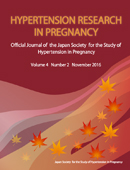Volume 1, Issue 2
Displaying 1-10 of 10 articles from this issue
- |<
- <
- 1
- >
- >|
Review
-
Article type: REVIEW ARTICLE
2013Volume 1Issue 2 Pages 57-65
Published: October 24, 2013
Released on J-STAGE: January 29, 2014
Download PDF (781K) Full view HTML -
Article type: REVIEW
2013Volume 1Issue 2 Pages 66-70
Published: October 24, 2013
Released on J-STAGE: January 29, 2014
Download PDF (734K) Full view HTML
Original Articles
-
Article type: ORIGINAL ARTICLE
2013Volume 1Issue 2 Pages 71-74
Published: October 24, 2013
Released on J-STAGE: January 29, 2014
Download PDF (714K) Full view HTML -
Article type: ORIGINAL ARTICLE
2013Volume 1Issue 2 Pages 75-80
Published: October 24, 2013
Released on J-STAGE: January 29, 2014
Download PDF (789K) Full view HTML -
Article type: ORIGINAL ARTICLE
2013Volume 1Issue 2 Pages 81-87
Published: October 24, 2013
Released on J-STAGE: January 29, 2014
Download PDF (1052K) Full view HTML -
Article type: ORIGINAL ARTICLE
2013Volume 1Issue 2 Pages 88-92
Published: October 24, 2013
Released on J-STAGE: January 29, 2014
Download PDF (766K) Full view HTML -
Article type: ORIGINAL ARTICLE
2013Volume 1Issue 2 Pages 93-97
Published: October 24, 2013
Released on J-STAGE: January 29, 2014
Download PDF (857K) Full view HTML -
Article type: ORIGINAL ARTICLE
2013Volume 1Issue 2 Pages 98-102
Published: October 24, 2013
Released on J-STAGE: January 29, 2014
Download PDF (742K) Full view HTML -
Article type: ORIGINAL ARTICLE
2013Volume 1Issue 2 Pages 103-107
Published: October 24, 2013
Released on J-STAGE: January 29, 2014
Download PDF (706K) Full view HTML -
Article type: ORIGINAL ARTICLE
2013Volume 1Issue 2 Pages 108-112
Published: October 24, 2013
Released on J-STAGE: January 29, 2014
Download PDF (757K) Full view HTML
- |<
- <
- 1
- >
- >|
